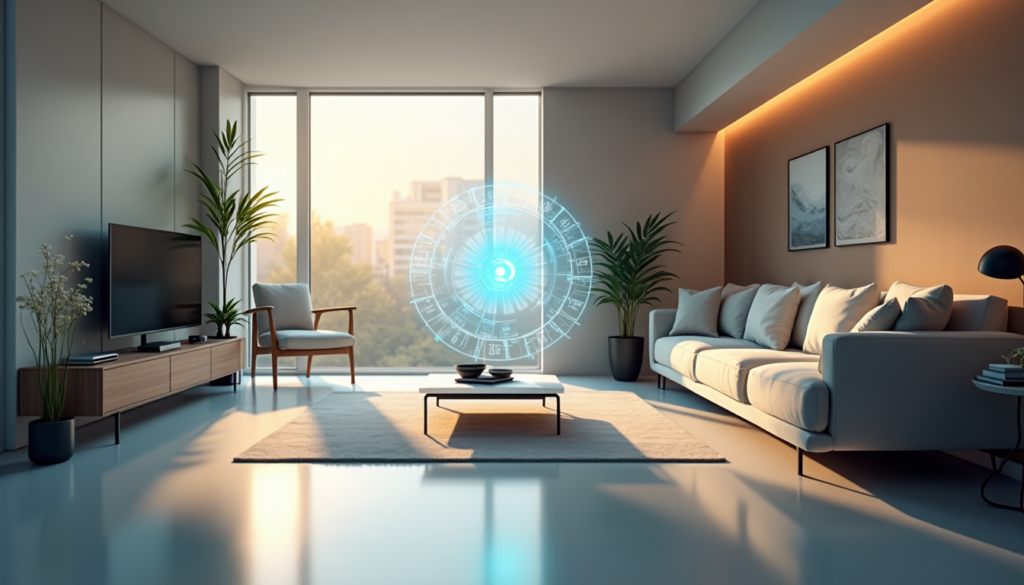
AI today surrounds us in ways most people don’t even notice. From the moment you wake up until you go to bed, artificial intelligence quietly powers dozens of daily activities you might think are purely human-driven.
Actually, AI has become so integrated into our lives that distinguishing between AI-assisted and non-AI tasks grows harder each day. Whether you’re working, relaxing at home, or running errands, artificial intelligence shapes your experiences in both obvious and subtle ways. This article explores the real-world applications of AI in 2025, specifically focusing on how it affects your home life, work environment, and daily routines.
How AI Changed Home Life in 2025
Smart homes in 2025 have evolved beyond simple automation into intelligent living spaces that learn and adapt to your daily routines. Home AI systems now understand natural language commands, allowing users to control multiple functions through complex instructions like turning off downstairs lights while playing music in specific rooms [1].
Health monitoring has become seamlessly integrated into daily life. Remote patient monitoring systems, coupled with AI, analyze vital health data and generate early warning alerts [2]. These systems have shown remarkable success, particularly in cardiovascular monitoring, which dominates 74% of the US market.
Meanwhile, AI-powered security systems have advanced significantly. Yale’s smart cameras feature intelligent detection that reduces false alarms and can even alert homeowners when packages arrive at their doorstep. Furthermore, energy management has become more sophisticated, with systems automatically adjusting settings based on weather conditions and daily patterns.
The kitchen, notably, has undergone a significant transformation. AI meal planning assistants now analyze your refrigerator contents, dietary preferences, and schedule to suggest personalized recipes. Smart refrigerators track inventory and automatically generate shopping lists when supplies run low. Consequently, these systems have helped reduce food waste while ensuring healthier eating habits.
Mount Sinai’s AI-driven analytics platform has demonstrated the effectiveness of these smart home health systems, decreasing hospital readmission rates by 25%. Additionally, users of wearable health technology have reported a 27% increase in physical activity levels, showing how AI today actively promotes better wellness outcomes.
AI at Work: New Ways We Do Things
The workplace landscape has undergone profound changes as organizations embrace AI tools across various functions. Studies show that AI-supported workers achieve 66% higher productivity compared to traditional methods. This boost equals 47 years of natural productivity gains in the United States.
Essentially, AI has reshaped how teams operate, with middle managers now leading blended teams of human workers and digital assistants. Rather than replacing jobs, AI tools act as “forklifts for the mind,” handling data-heavy tasks and freeing up workers for creative thinking.
The impact varies across skill levels. Indeed, studies reveal that less-skilled workers benefit more from AI assistance, with the bottom 20% of performers showing a 35% improvement in task completion. Moreover, AI helps new employees achieve expertise faster than those working without AI support.
Here’s how AI boosts workplace efficiency in 2025:
- Real-time meeting transcription and automated task assignment
- Instant translation for global team collaboration
- AI-powered project management predicting deadlines and identifying potential issues
- Automated recruitment processes, including job description creation and candidate sourcing
Overall, organizations are moving beyond experimentation, making AI an essential part of their business planning. Accordingly, workplace tools have evolved to include features like emotion recognition in communications and automated meeting summaries. Primarily, this shift allows teams to focus on strategic thinking and complex problem-solving, as AI handles routine tasks and data analysis.
The Hidden AI in Your Daily Tasks
Behind everyday conveniences lies an intricate network of AI systems working silently. Banking institutions now employ AI to detect fraudulent activities in real-time, protecting consumers from financial theft. Similarly, AI algorithms analyze spending patterns and transaction histories to offer personalized financial advice.
In entertainment, streaming platforms have evolved beyond simple recommendations. Netflix’s AI engine curates personalized thumbnails for each viewer, subsequently affecting what content catches your eye. Spotify’s AI creates tailored playlists by analyzing not just your music preferences, but also factors like tempo, key, and mood.
Transportation systems have become smarter and more efficient. Cities now use AI to optimize traffic flows and improve safety in public spaces. AI-powered algorithms help manage mobility fleets, ensuring vehicles are available when and where needed. Hence, your smooth commute often results from AI working behind the scenes.
Here’s how AI quietly assists your daily activities:
- Spam filters use AI to protect your inbox from unwanted emails
- Voice assistants process natural language for hands-free banking
- Streaming services automatically adjust video quality based on your internet speed
- AI-driven image processing identifies vehicles at intersections for better traffic management
Although these systems operate invisibly, their impact is substantial. Banks report significant improvements in fraud detection, primarily through AI’s ability to analyze vast amounts of transaction data in real-time. Subsequently, this technology has made financial services more secure and personalized, while maintaining seamless user experiences.
Conclusion
Undoubtedly, AI has become the invisible force shaping our daily experiences in 2025. Smart homes now safeguard our health and comfort, while workplace AI tools have transformed productivity across skill levels. The technology’s reach extends far beyond obvious applications, powering everything from fraud detection in banking to personalized entertainment experiences.
These advancements represent more than mere technological progress. AI systems have proven their worth through measurable impacts – 25% lower hospital readmission rates, 66% higher workplace productivity, and safer financial transactions. Therefore, the question shifts from whether AI belongs in our daily lives to how we can best use these tools.
Above all, AI today serves as an enabler rather than a replacement, amplifying human capabilities while handling routine tasks. As we have seen across homes, workplaces, and cities, artificial intelligence continues to evolve, making our lives safer, more efficient, and increasingly connected. The real power of AI lies not in its complexity, but in its ability to simplify our daily challenges while operating quietly in the background.